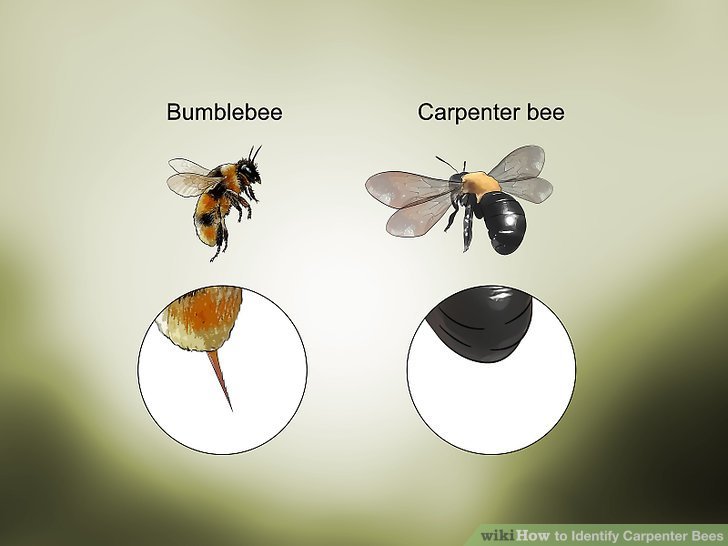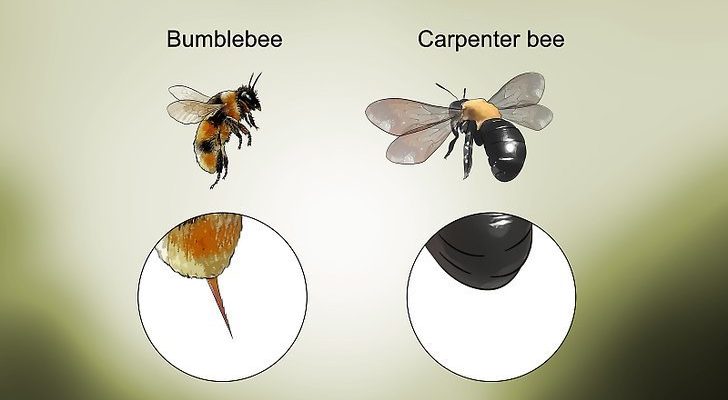
Imagine carpenter bees as the “woodworkers” of the bee world. They don’t make honey like honeybees do, but they are masters of turning wood into cozy nests for their young. Let’s break down how to identify these buzzing buddies so you can decide what to do next.
What Are Carpenter Bees?
Carpenter bees belong to the genus *Xylocopa* and are commonly found throughout North America. They are solitary creatures, which means they don’t form hives like honeybees. Instead, each female bee creates her own nest in wood. You might wonder, “What kind of wood?” Well, they prefer unpainted or untreated softwoods like cedar, pine, and fir.
Visually, carpenter bees are quite striking. The males are often mistaken for bumblebees due to their similar size and coloration, but here’s a fun fact: male carpenter bees are usually more golden-brown, while females sport a shiny, black abdomen. This is a distinctive trait that makes it easier for you to identify them when they’re buzzing around your yard.
Recognizing Carpenter Bee Behavior
You might be curious about how carpenter bees behave and why that matters. They usually emerge in the spring, and if you’ve got a wood feature like a deck or patio, you might see them doing their thing. The females are responsible for drilling small, perfectly round holes into the wood, and they can create tunnels that can reach up to ten feet long!
One of the things that sets carpenter bees apart from other types of bees is their interest in drilling holes. If you see a bee hovering around a wooden structure, there’s a good chance it’s a carpenter bee. You might even catch them buzzing around the entrance of their nest as they guard their territory.
However, the males don’t sting. They might approach you in a rather bold manner, but don’t worry—they’re all bark and no bite. They hover around to show off, but aren’t interested in stinging humans.
Visual Characteristics of Carpenter Bees
Now, let’s dive into how you can pick out a carpenter bee just by looking at it. To start, they can be anywhere from half an inch to one inch long, making them one of the larger bee species. Their body shape is robust and pill-shaped, which gives them a hefty look.
Here are some key characteristics to keep an eye out for:
- Coloration: Black and yellow with shiny, hairless abdomens for females; golden or furry bodies for males.
- Size: Usually about an inch long.
- Behavior: Slow-flying and often hovering around wood.
If you’ve got a few wood structures that have seen better days, take a moment to look carefully. The holes they drill are about the size of a dime—if you see those, congratulations! You’ve likely identified a carpenter bee.
Signs of Carpenter Bee Infestation
If you have carpenter bees buzzing around your home, you might be wondering when that becomes a problem. The truth is, while they’re not prone to aggressive behavior like other wasps, they can cause significant damage if left unchecked.
Here are some telltale signs of infestation:
- Drill Holes: Small, round holes in your wooden structures.
- Wood Shavings: Piles of sawdust or wood shavings can often be found beneath their nesting sites.
- Sound: A buzzing sound can sometimes be heard from inside the wood, especially if you listen closely.
If you notice these signs, it might be time to take action. Ignoring them can lead to structural damage in your home, which is never a fun situation!
How to Differentiate Carpenter Bees from Other Bees
With so many bee species out there, distinguishing carpenter bees from other types can feel a bit challenging. For instance, bumblebees are social and live in colonies, while carpenter bees prefer a solitary lifestyle. Additionally, bumblebees have a fuzzy abdomen that’s covered in hair, whereas carpenter bees have a smooth, shiny butt.
Here’s a quick comparison:
| Feature | Carpenter Bee | Bumblebee |
| Body Shape | Pill-shaped | Round and fuzzy |
| Color | Black with some yellow | Yellow and black |
| Behavior | Solitary | Social |
When you get to know these differences, you’ll feel much more confident in identifying carpenter bees when you see them.
What to Do If You Find Carpenter Bees
So, you’ve identified carpenter bees in your backyard. Now what? First things first: don’t panic! While you don’t want them damaging your wood, there are humane ways to manage them.
Here are some approaches to consider:
- Seal Up Holes: If you see holes, fill them with a suitable material to prevent future nesting.
- Paint and Treat Wood: Carpenter bees prefer untreated wood, so painting or sealing can deter them.
- Natural Repellents: Consider using peppermint oil or citrus sprays; bees typically dislike these scents.
If the infestation becomes overwhelming, you might want to consult a pest control professional. They can help you find a method that’s safe for the bees while also protecting your home.
The Importance of Carpenter Bees
Before wrapping things up, let’s chat about why carpenter bees aren’t all bad. These little guys play a crucial role in our ecosystem. They help with pollination, especially of plants that other bee species may overlook. This is essential for many flowers and crops, so they really do have their benefits.
Plus, remember that their presence can indicate the health of your garden and yard. A diverse range of pollinators is a good sign of a thriving environment.
In conclusion, knowing how to identify carpenter bees is a handy skill, especially if you want to protect your home while appreciating nature’s wonders. With their unique characteristics, behaviors, and roles in the ecosystem, these wood-dwelling bees deserve a little respect—even if they do cause some concern for homeowners. Next time you spot one buzzing around, you’ll have a better understanding of what it is and what steps to take. Happy bee watching!

